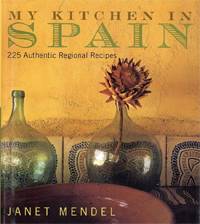 |
 Tapas Tapas
Tapas is enjoyed in bars all over Spain. People eat tapas
in the evening, either before or after an evening meal, but
isnt normally eaten as the main meal. Think of tapas as snacks
that you eat whilst having a drink. Each tapas bar will have
its own speciality, and it is worth going from bar to bar to
sample a little of each.
We have recipes for Garlic
Prawns (Gambas al Ajillo) and Mushrooms
in Garlic Sauce (Champiņones al Ajillo).
Easy Tapas
The Spanish hams, sausages and cheeses becoming available
abroad in an ever-widening range make easy tapas.
Walk into a Spanish tapas bar worthy of its name and the first
thing that hits you is the variety: Pickles on cocktail sticks,
cheeses and hams, homely omelettes, baby earthenware casseroles
with sizzling hot dishes and elegant mayonnaise-topped mouthfuls.
It's the chance to dip into so many tastes, as well as the
visual spread of tapas that make them universally appealing.
But behind the apparently bewildering variety are certain
clear principles. Originally a mouthful of food included in
the bar-price of a fino, wine or beer, a tapa is designed to
accompany drink and good conversation. Or as journalist Pedro
Soleras put it in the newspaper El País last year, "The
tapa, invented in an age less obsessed with productivity, is
a trick for spinning out your drinks without getting drunk".
And whether thirst provoking or absorbent, they should be easy
to eat so they don't interrupt the flow of conversation.
Another point is clear too. Even though they are now to be
found in homes and smart restaurants, tapas have kept an informal
spirit through their popular origins as street-food. So don't
hold back. There's always room for improvisation around the
ingredients that come to hand and the cook's personality. Treat
the recipes below simply as a springboard for your own ideas.
Quickest of All: Quality in a Can.
Some of the most traditional tapas are also the speediest
fast food, taking only as long to prepare as you need to open
a tin. The most obvious example are the wide variety of canned
olives: whole or pitted, stuffed with almonds or anchovies,
cracked and canned in marinades.
But in many an old-fashioned Spanish bodega bar, tapas from
cans, or latas as they are called, cover a much broader range.
Listed on chalked-up menus under that heading, they might include
clams, cockles and razorfish in their juices; anchovies, sardines
and tuna fillet in olive oil; mussels or tuna in escabeche
(marinade). These will usually be on display in large drum-like
tins behind the counter so customers can check their quality.
All are considered delicacies to be savoured in their own right,
fished out onto a dish and served with bread. In recent years
the range has grown, too, with the arrival of new gourmet preserves
such as elvers, crawfish, sea-urchin coral and baby octopus
in olive oil.
Such instant tapas can be made a little more solid by spearing
them with bread on a stick or laying them on toast dribbled
with olive oil and rubbed with garlic. Or they can be made
more elaborate, if still foolproof, by combining them - say
tuna with roasted red pepper - to hit your tastebuds with a
satisfying combination of flavors.
Ham, Charcuterie and Cheese.
The Spanish hams, sausages and cheeses that are becoming available
abroad in an ever-widening range make equally easy tapas. A
ración, or sliced plateful, could be of fine or coarse-cut
chorizo, salchichón, cured loin or ham. All can now
be bought handily vacuum-packed in counted slices as well as
loose by weight from delicatessens. Remember that if you are
cutting you own Iberian cured ham made from native black-footed
pigs, it needs to be sliced along the grain into water-thin,
translucent slices to bring out its full aroma and flavor.
Likewise, it is now possible to make up a varied tabla de quesos,
or cheeseboard, of the Spanish cheese being newly exported.
One unusual addition you can make easily for yourself is deliciously
nutty Manchego cheese preserved in olive oil. The cheese is
cut into cubes or triangles and small holes pricked in it so
the oil soaks in well. This keeps for up to a year, with the
flavor maturing all the time, but you can dip into it after
a month.
Instant Hot Tapas.
Another good trick for adding variety to tapas if you're either
pressed for time or if you're a reluctant cook is to open a
jar or can of a preserved cooked dish with a strong whiff of
Spain. Again the range has not only widened but also improved
enormously in quality. Squid cooked in its ink, braised Mediterranean
vegetable pisto from La Mancha, braised partridge, quail in
escabeche and tuna fish with green peppers are only few examples
of high-quality preserved dishes that you can serve as they
are, use to fill pastry cases or serve on toasted rolls.
Recommended reading
 |
My Kitchen in Spain: 235 Authentic Regional Recipes Celebrating Vibrant
Regional Flavors - Janet Mendel
This collection of authentic recipes from Spain includes such specialties
as gazpacho and several versions of paella, as well as lesser known dishes,
highlighted by rich culinary, cultural and historical information. |
|
 |




